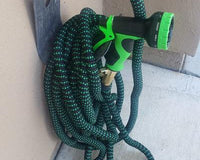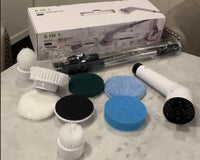Gardening is a beautiful and rewarding endeavor, but it requires careful attention to detail. One of the most critical factors in gardening success is efficient watering, ensuring that your plants receive the right amount of moisture without wastage. This is where a 100 Soaker Hose can be a game-changer for garden enthusiasts. In this comprehensive guide, we'll walk you through the process of installing a 100 Soaker Hose system to help you achieve the garden of your dreams.
1.Understanding the 100 Soaker Hose
Before we dive into the installation process, let's take a closer look at what makes the 100 Soaker Hose an excellent choice for gardeners.
Efficient Permeation: The 100 Soaker Hose utilizes advanced technology to ensure even water permeation. This means that water is delivered directly to the roots of your plants, minimizing wastage and promoting healthy growth.
Water Conservation: Soaker hoses are designed to minimize water wastage. By delivering water directly to the root zone, they use water more efficiently than traditional watering methods. This not only conserves water but also contributes to environmental sustainability.
Durability: Made from premium materials, 100 Soaker Hoses are built to withstand various weather conditions, ensuring they last for seasons to come.
Easy Installation: These hoses are lightweight, flexible, and easy to set up. Whether you have sprawling garden beds or need to maintain consistent moisture levels around your foundation plants, installing a soaker hose is a hassle-free process.
Warranty: Lefree's 100 Soaker Hose comes with a warranty to provide you with peace of mind and protect your investment.
2.Now, let's move on to the installation process:
Step 1: Gathering Your Tools and Materials
Before you begin, ensure that you have all the necessary tools and materials:
A 100 Soaker Hose system
A garden hose or a soaker hose connector
Garden stakes or landscape staples
A hose splitter (optional)
A water source
A timer (optional)
Step 2: Layout and Positioning
Determine where you want to place your soaker hose. Lay it out strategically to cover your garden beds or the areas where you want to provide consistent moisture.
Step 3: Connecting the Soaker Hose
Attach the 100 Soaker Hose to your garden hose or use a soaker hose connector. If you have a large garden, consider using a hose splitter to connect multiple soaker hoses for even coverage.
Step 4: Securing the Hose
Secure the hose in place using garden stakes or landscape staples. This prevents it from shifting while watering.
Step 5: Testing and Adjusting
Turn on the water source to test the soaker hose. Make any necessary adjustments to ensure even water distribution. You can control the water flow by adjusting the water pressure at the source.
Step 6: Timer (Optional)
For added convenience, consider installing a timer to automate your watering schedule. This helps ensure that your garden receives consistent and timely moisture.
3.Maintenance and Tips
To maintain your soaker hose system and maximize its lifespan, follow these tips:
Winter Storage: Before winter, ensure that the hose is drained completely to prevent blockages, especially in areas with hard water quality.
Periodic Cleaning: Regularly clean the hose to prevent clogging due to mineral buildup.
Adjust as Needed: Keep an eye on your plants and adjust your watering schedule as necessary. Soaker hoses are flexible and adaptable.You can buy it on Lefree Website,Please click the link:100 Soaker Hose
4.Real User Experiences
Many gardeners have experienced tremendous success with a 100 Soaker Hose system. For instance, Jane from California shared her story: "I've always struggled to maintain my garden in the arid Californian climate. Since I started using Lefree's 100 Soaker Hose, my plants have thrived, and I've significantly reduced my water bills. It's a game-changer."
Customer Voice about this:More than 6000+ Positive User Feedback

5.Creating a Sustainable Garden Environment
Integrating the Soaker Hose system with other elements of eco-friendly garden design contributes to the development of a more sustainable garden environment:
5.1 Rainwater Harvesting System: Combine the Soaker Hose system with rain barrels or a rainwater harvesting system to maximize the utilization of natural precipitation. By using rainwater in conjunction with the Soaker Hose, you can reduce dependence on traditional water sources, achieving a more sustainable irrigation system for your garden. Ensure the proper installation of rain barrels and connect them to the Soaker Hose with suitable pipelines to efficiently direct rainwater to the plant roots.
5.2 Use of Organic Fertilizers: Employing organic fertilizers in conjunction with the Soaker Hose system can further enhance the sustainability of your garden. Organic fertilizers not only promote plant growth but also contribute to improving soil quality. This soil enhancement helps increase soil water retention capabilities, making it more suitable for the efficient irrigation provided by the Soaker Hose.
5.3 Plant Selection and Arrangement: In garden design, choose plants that are adapted to the local climate and soil conditions to reduce reliance on external resources. Thoughtful plant combinations can form mutually beneficial ecosystems, enhancing overall resistance to pests and diseases and reducing dependence on chemical pesticides.
5.4 Application of Mulch: Apply an organic mulch layer, such as wood chips, straw, or grass clippings, around the base of plants to slow down water evaporation, maintain soil moisture, and reduce the frequency of Soaker Hose system usage. This aids in further water conservation while improving soil structure.
5.5 Regular Monitoring and Adjustment: Establish a systematic approach to regularly monitor the garden's condition, allowing adjustments to the frequency of Soaker Hose usage based on the actual needs of the plants. This can be achieved by observing plant growth, soil moisture levels, and weather conditions. Timely adjustments to the irrigation schedule can minimize water wastage.
5.6 Waste Recycling: Utilize composting with waste materials to produce organic fertilizers, promoting the recycling of waste. This not only benefits the environment but also contributes to the development of a more sustainable garden system.
By implementing the above recommendations collectively, integrating the Soaker Hose system with other elements of eco-friendly garden design can significantly improve water resource efficiency, reduce reliance on chemical substances, and foster the flourishing growth of a garden that is both environmentally friendly and vibrant.
Learn more about:soaker hose 100 ft
Learn more about:100 foot soaker hose
6.In conclusion, installing a 100 Soaker Hose system from Lefree is an eco-friendly and efficient way to nurture your garden. With proper installation and maintenance, you can look forward to a flourishing garden, water savings, and a greener, more sustainable lifestyle.
Make the smart choice today and invest in a 100 Soaker Hose to transform your garden into a thriving oasis.
Amazon Shopable Link:https://amzn.to/3NWf40z
or Buy on Our Website:100 Soaker Hose














